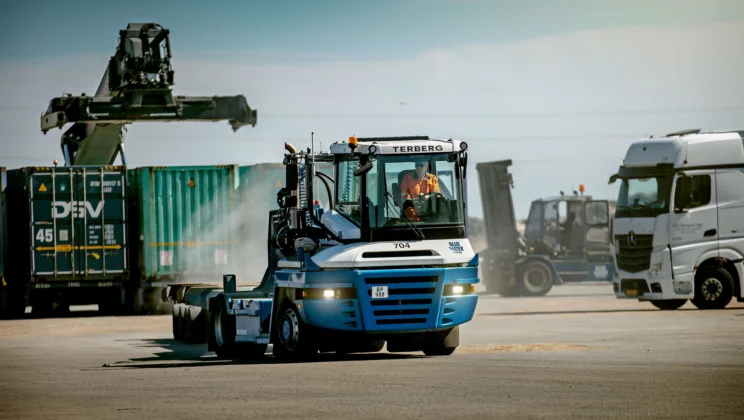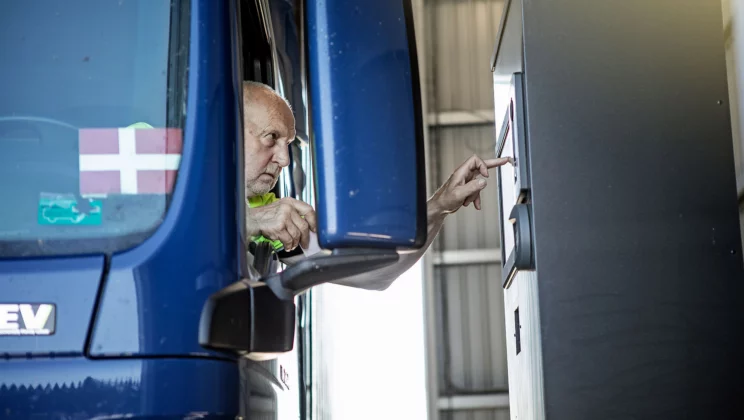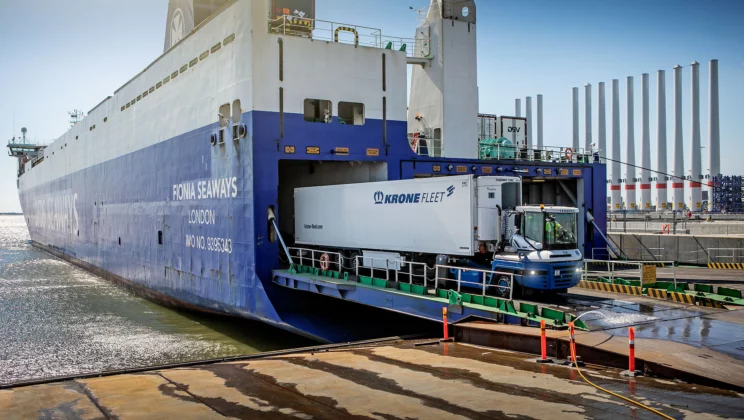It has required an investment of about DKK 100 million, but has also clearly become Denmark's most modern RoRo port terminal, says Blue Water about the new terminal in the East Port. With its 116,000 square metres, it can accommodate a total of 1,000 containers and 750 trailers at once– and almost think for itself.
The crane resembles a 'Transformer' standing on the quayside. It looks rather like something from a science fiction series, and could perhaps also be mistaken for a prop from the Star Wars universe.
"You have to be a bit of a Jack the Lad to think this stuff is fun, but then again, that’s me," says Per Jensen with a smile. As Head of Port Services and Agency, he is responsible for the development of the new Blue Water terminal in the East Port. He is a former ship master and mate, but today is sitting behind the wheel of a car, showing us around the area.
The crane in front of us is, in fact, not so high tech, but still belongs to the new terminal universe.
In the back seat of the car we are driving around in sits Kim Fialla. Whereas Per Jensen has a background in shipping, Kim Jensen is a merchant with a master's degree in market economy. He is also an expert in processes, structure and strategy.
Their different skill sets have been crucial in connection with preparing the new terminal. The work kicked off in August 2017 in close dialogue with DFDS, who wanted to get started quickly, and from then on things happened quickly. By 23 December, the area was already in use, even though it was only 80 percent complete, and the buildings are only now nearing completion.
"It was not optimal, but sufficient," says Per Jensen.

The work kicked off in August 2017 and by 23 December, the area was already in use.
High-tech reception
Digital check-in equipment is installed at the gate leading to the sealed-off area of the terminal. Whereas in the past, truck drivers had to have physical papers, now they just dial a code and are designated a space in the terminal, and possibly a container to take out with them. The system itself calculates the best location in relation to the ship, depending on the contents of the trailers or containers onboard the ship.
The automatic check-in system had to be translated into 16 languages, including Ukrainian and Romanian.
Cameras are also installed as part of the new check-in system to show trucks and containers from all possible angles. This makes it possible to monitor the condition of the containers and know exactly what is being driven, when and where. Or whether any damage caused by reversing was already visible on the container when it arrived.
There is also an alarm if a refrigerated container heats up to four degrees instead of two degrees.
"This is without comparison Denmark's most advanced RoRo terminal," says Kim Fialla, who holds the official title of the Head of Business Development & Finance, Blue Water Port Service Division.
This is partly due to the fully automatic ship operation. The system automatically assigns the container locations – both on the quay, where they must be grouped in relation to environmental approval, so that paint and gas are not stored next to acid, for example. But also on the ships, where there must be space on the frequently large vessels with 3-4 decks. The system incorporates all the data, and then the docker is automatically notified via a tablet of where he should drive the terminal tractor and place the container. Efforts are still being made to ensure the system goes completely live, but it is close.

Whereas in the past, truck drivers had to have physical papers, now they just dial a code and are designated a space in the terminal.
Large mouthful
Blue Water handles about six calls a week from DFDS ships and three from other shipping companies. Typically, 200 units are unloaded and loaded every time a ship docks, so the terminal is busy and great demands are made on logistics, especially at weekends.
Kim Fialla admits that it has been a large mouthful getting the terminal up and running before it was completely finished.
"It has been a tough struggle being fully operational while the terminal was incomplete and we were continuously finalising the IT systems. Customers and employees have been somewhat frustrated, but we are nearly there," he says.
Underground valves safeguard against spills
Underground valves are another of the terminal's new features that, among other things, are designed to prevent dangerous liquids from leaking into the sea. In the event of a container leak, the digitally controlled underground valves make sure the spill is contained, so it does not end up in the water and only reaches a limited part of the sewer system. In fact, the system can even detect the smell of turpentine, for example. Thus, the system also prevents flammable material from moving in connection with stored dangerous goods.
"It's been insanely demanding getting everything in order, but on the other hand, it is also really impressive, I think," says Kim Fialla.
As the valves are not visible above ground, we cannot see them from the car as we drive around.
However, we can see a newly built garage where a number of Land Rovers, Range Rovers and Jaguar E-PACE cars are being prepared, ready to be driven out to the buyers.
"Remember to save one for me," Per Jensen calls out of the car window to an employee cycling by, who smiles and winks back.
The bike is needed to get around on the 116,000 square-metre site, corresponding to 16 football fields, which has required an investment of just over DKK 100 million for Blue Water to become a reality.

The new terminal is a 116,000 square-metre site, corresponding to 16 football fields, which has required an investment of just over DKK 100 million for Blue Water.
Wind gives hope
High wind turbine towers stand beside the terminal, and this is where the enormous 161-metre-long installation ship Pacific Orca is berthed, taking up a lot of space in the harbour. MHI Vestas is Blue Water's neighbour. The wind turbine industry is making increasing use of RoRo, and the prospects here are part of the reason that work on developing the new terminal has begun. A crane is about to lift a nacelle.
"We have great expectations that wind will be even more relevant to us in the long term," says Per Jensen from his seat behind the steering wheel of the car, while looking expectantly towards the ship. And then he smiles widely.
Investment in the future
The new terminal can be considered a product that has been developed, like so much else. Therefore, the idea is also, over time, for the product to be used elsewhere. For example, Blue Water also has another RoRo terminal in Esbjerg. And then there is a terminal in Aarhus, where many of the new initiatives can be used.
"Now, we have taken the rough ride regarding developing this terminal. Next time the IT systems will be in place from the start, so in that way we will benefit further from the good experience we have gained. We are looking forward to it, "says Kim Fialla.
The car door slams and the tour is over. Although the terminal is not 100 percent complete, it is close to it. Blue Water is counting on its gate soon being completely unmanned, so drivers can check in and out around the clock. A great advantage for shippers.
"It should be in the near future. This is another big plus with this project, "says Kim Fialla.

Blue Water plans to copy many of the terminal's new features to other terminals.
Go to overview

